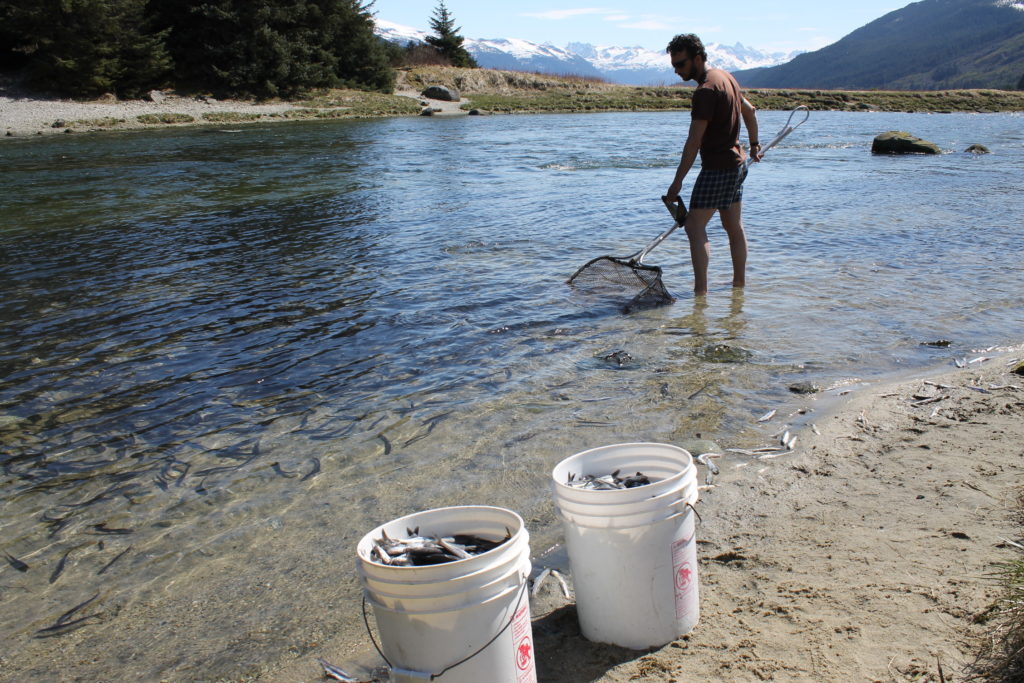
Once again, the Chilkat and Chilkoot rivers are turning black with little fish scrambling upstream. The eulachon, commonly known as hooligan, are running in full force and all kinds of different species are loving it.
At the mouth of the Chilkoot river, there’s a feeding frenzy happening. Birds dip beaks and talons into the water, pulling out small black and silver fish with every swoop. Off in the distance, a raft of sea lions gorges on the scaley bounty of the lutak inlet. A couple humans are enjoying the run as well.
Zephyr Sincerny waded out in the river barefoot, scooping up hooligan with a net. He said his net is a bit heavy for harvesting the fish, but he has worked out a system.
“What I end up doing is I take it out into the fish and set it on the bottom a little bit, and then I just wait,” Sincerny said. “They usually end up flowing back and kind of swimming into the net or settling into it. Then I just lift up, and out we go.”
Sincerny said the run seems a little bit smaller than last year, but in just 20 minutes he can fill two five-gallon buckets. That is all he needs. At home, he will smoke, brine and add spices to the fish. Then he will vacuum seal and freeze them to enjoy for the rest of the year. He always makes sure to set aside some fish for his dog, though.
“You know we were buying fish oil to feed him, and that didn’t make a lot of sense figuring that that’s pretty expensive and we have a really great resource,” Sincerny said.
Just upstream from Sincerny, a team of researchers from the Chilkoot Indian Association (CIA) collected data for a study on hooligan. Shaleena Bott is doing an internship with CIA. She used a metal y-shaped fish trap to collect the fish.
“We are capturing some hooligan, and we’re clipping the adipose fin. And then we’ll send up another team in a little bit to go up and count each of the hooligan to see if we can either see a marked fish or not. And then we put in a bunch of numbers to see what their biomass is,” Bott said.
Despite their popularity and abundance during runs, little is known about hooligan. Takshanuk Watershed Council’s Executive Director Meredith Pochardt, who is involved in the hooligan study, said researchers are still trying to figure out questions about their life cycle.
“Do they actually die after they spawn? There’s also some evidence that points to maybe having multiple spawners in certain populations. And also learning a bit more about the age they return to the rivers,” Pochardt said.
Unlike salmon, it is believed that hooligan return to a stream in their region rather than the stream where they were spawned. According to Ted Hart, a fisheries specialist for the Chilkoot Indian Association, the location they return to depends on a variety of factors.
“Usually see a good amount go to Chilkoot, so I think they might prefer Chilkoot. But if the conditions aren’t right then they’ll head off and they can go to Skagway or they can go Ferebee also, or the Katzehin.” Hart said.
CIA started collecting data on hooligan populations on the Chilkoot River eight years ago. Last year the association secured a grant for the study, and with help from the Takshanuk Watershed Council the research has expanded to 11 different rivers around the Upper Lynn Canal. Pochardt said this has given a much broader perspective on the fish.
“When we have the lower returns on the Chilkoot, that perhaps doesn’t mean that the whole northern Lynn Canal population is in decline, that could mean that maybe another river is seeing a higher return than normal,” Pochardt said.
For generations, people have subsistence fished for hooligan, or saak in Tlingit. Hart said the oil from the fish has countless health benefits and has long been a valuable resource for this region.
“It’s like liquid gold,” Hart said.
Hart hopes this research will ensure that future generations can depend on this harvest.
This year’s run was a few days later and smaller than last year’s unusually large run of 12 million fish. Hart attributed this to colder temperatures this spring that kept Chilkoot lake frozen for longer.
“Presumably, some came up to the Chilkoot and the river may have been too low, so some decided to go over to the Taiyasanka. Looked like a pretty decent showing over there,” Hart said.
Initial estimates show that 8.7 million hooligan came back to the Chilkoot this year.




